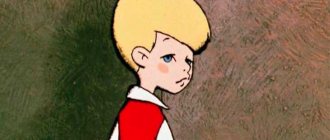When faced with a problem, do you strive to find as many solutions as possible? Do you use familiar things in everyday life for purposes other than their intended purpose? Do you have any artists, musicians or poets in your family? Do you often have crazy, unusual, and unlike anything thoughts come into your head? Can you act spontaneously, spontaneously, without much thought? Do you often imagine animals or objects instead of your friends?
Once you answer these questions, consider yourself to have passed a rapid test of creative thinking. If in most cases the answer is “yes”, then you have it; if “no”, it’s time to start developing it. What is it, why does modern man need it, and can it be somehow improved?
Creative thinking in psychology
In psychology, creativity is interpreted as a certain mental activity, practical or theoretical, as a result of which new hypotheses, proposals, and methods for solving them arise. It plays a large role in science, where creative people provide serious assistance in discoveries due to the fact that they think more broadly and act more boldly.
Note! Creative thinking is constructive, the task of which is to discover everything new and unique.
Psychology emphasizes the main non-standard characteristic of this thought process, which is its creativity. Broadness of thinking can be achieved through the development of imagination, starting from a young age in preschoolers. Training can be done with adults, but the process will take longer.
Age characteristics
Preschoolers
Children with creative thinking can be distinguished from the general crowd even in kindergarten. They don’t like to perform synchronous, identical movements with everyone else (for example, during morning exercises) and come up with their own. In the game, they take the initiative because they are simply bursting with ideas on how best to distribute roles and what to place where. However, other guys often don’t understand them, because they think in original images. Instead of eating an apple for an afternoon snack, they nibble it in such a way as to make some kind of figure.
However, it is not always possible to recognize the creative potential in a little person. They are often secretive, because they are too focused on their inner world and images. Drawing with a plot helps to identify the levels of creative thinking of preschoolers.
Typically, tests to determine the level of creative thinking are carried out in preschool children (5-6 years old), so that the data obtained can be used in the future - when studying at school.
Primary School
From grades 1 to 4, the creative thinking of younger schoolchildren is characterized by the following features:
- quickly solving educational problems (using non-standard methods);
- identifying potential in a specific area (music, literature, drawing, modeling);
- unusual judgments, your own view of the familiar world;
- refusal to perform template tasks according to the sample;
- inattention in class.
The main task of teachers and parents at this stage is to recognize the child’s creative potential and direct all efforts to its development. If the moment is missed in elementary school, these abilities may remain unrealized in the future. As psychologists say, this is where humanity loses the most great artists, musicians and poets.
In elementary school, it is also important to separate the “wheat from the chaff.” At this age, many children play out their fantasy and substitution of concepts occurs. Inspired by the tales of their talented child, parents begin to see in him a great writer who in the future will become an unsurpassed science fiction writer. In fact, these are fictions, most often based on computer games and films. There is no creativity or anything unique there. In psychology, imagination (closely related to creative thinking) and fantasy are completely different concepts.
Middle and senior management
In the middle and senior levels, creativity becomes much clearer. Teenagers are already capable of self-determination without the guidance of adults. Those whose creativity is off the scale occupy positions of leaders of various school and youth associations. The generation of unusual ideas, non-standard ways of solving problems and pressing tasks make them the center of everyone's attention. Others begin to express themselves in some narrow specialization - they become real stars of the local theater group or art studio.
At this age stage there are dangers. Closer to the age of 13, on the threshold of the teenage crisis, creative thinking can play a disservice. In an attempt to prove to everyone their adulthood and independence and due to youthful maximalism, such children begin to too clearly and ardently demonstrate their vision of the world - different from others. All this is accompanied by aggression and daring behavior. The support of parents who can direct all this in the right direction is of great importance here.
Definition
Creative thinking - what is it in psychology
Human creative thinking is the process of getting acquainted with information, processing it and creating new ideas. In pedagogy, the importance of this type of thinking is noted due to the fact that the individual independently strives to obtain new knowledge and quickly apply it in practice. This applies not only to music and drawing lessons, but also to history, social studies, etc. In addition, speaking about children with a predisposition to this type of thinking, the importance of having this criterion for learning, as well as socialization, is noted.
Plan of the education
The entire training is divided into several lessons that are designed to reveal different aspects of creative thinking in you. After completing all the lessons, you will receive a handicap in order to be able to apply and constantly improve your creative thinking.
Lesson 1. Lateral thinking
In order to think outside the box and create something truly new, it is useful to understand how to break the pattern and come to a new idea. This lesson will describe Edward de Bono's lateral thinking scheme as interpreted by the famous marketer Philip Kotler. Understanding the creative thinking process will help you understand how to make your creative process more productive. There is a misconception that creativity and creativity are antipodes to logic. Unconventional thinking is often compared to intuition, sudden inspiration, or the autogenic state of a person. However, creative unconventional thinking is not pure chaos in the mind. As the founder of the concept of lateral thinking, Edward de Bono, notes, the main difference between unconventional thinking and chaos and the thinking of mental patients is that the process of creative thinking is controlled. And even if unconventional thinking prefers to work chaotically, then this chaos can be controlled.
Lesson 2: Framing and Focusing
To create something new, you must choose the direction of your creative search. Without such a starting point it is simply impossible to move on. No matter how strange it may seem, the more clearly you define the framework, the easier it will be to create something new. This lesson shows the importance of choosing a focus and examines Robert Dilts' language focus patterns (framing), based on which you can begin the process of lateral thinking.
Lesson 3. Breaking the pattern
Now that we already know the algorithm for how to purposefully look at things from different angles, we can find the most appropriate focus (frame) in any situation. But something new has not yet appeared, since we simply changed the angle of view without changing the object itself. The process of lateral thinking has just begun. To continue this process we need to perform what is called a “lateral break” (template break, shear or displacement). It is breaking the pattern that will help us break the logic of thinking in order to come to new ideas. To create this shift, we need to construct a statement regarding the object of our focus, which will somehow change the object itself. In other words, we must think about how we can change an object or its individual characteristic. There are many techniques for creating this kind of change, but most of them can easily be boiled down to six basic ways to change anything.
Lesson 4. Developing creative imagination
After the lateral break was made, we had many mostly illogical (lateral) judgments. Now we have to take a step aimed at eliminating the resulting pattern gap. The upcoming stage is associated with work on the development of creative imagination to search and create full-fledged creative ideas from the metamorphoses obtained in the previous stages. In other words, in this class you will learn how to learn how to most effectively repair a lateral tear. This lesson describes the methods, principles and features of developing creative imagination, and also contains useful techniques, exercises and games.
Lesson 5. Developing creativity
At the last stage “Closing the gap” of the lateral thinking algorithm, in addition to creative imagination, human creativity also plays an important role. Creativity is the ability to accept and create fundamentally new ideas that deviate from traditional or accepted patterns of thinking. It is important to note that human creativity is a heterogeneous property that has several characteristics. The most common are the characteristics identified by the famous American psychologist Joy Paul Guilford back in the 60s of the last century. There are only four of these characteristics.
Lesson 6. Theories of creativity and creativity
Back in the 16th century, the outstanding English philosopher Francis Bacon complained that scientific discoveries were slow and largely accidental. He tried to find approaches and algorithms that would make it possible to turn the “creation of new things” into a systematic, constant process. A lot of time has passed since then, and today society has at its disposal many theories of creativity and creativity that help to look outside the box at existing problems and propose non-trivial solutions. These theories can be useful in a variety of areas of human activity. In this article we will review the most well-known and widely used techniques and concepts.
Features of creative thinking
Divergent thinking - what is it?
Creative thinking has little to do with actors, artists and musicians; not all people of this mindset are artists. An individual may have several thinking traits that determine his creative direction.
Among the features of creative thinking are:
- Uniqueness. The desire to create something new, be it an idea or an object. A creative person does not base himself on other people’s examples, he develops something of his own;
- Conceptual flexibility. The ability to apply a different point of view to a certain phenomenon in an attempt to consider it more broadly, in unusual variations in order to make it unique;
- Spontaneity. Free switching from one thought to another. Perception of information from different sources. The spontaneity of an idea arising in a situation that was not conducive to it;
- Heuristic. Transforming the familiar, going beyond the boundaries are essential skills in creative thinking.
An important property of creativity is going beyond the usual
The need to develop different types of thinking
It is important to have an idea of what type of creative thinking needs to be developed for situations and everyday life. Modern technologies allow you to choose the best option from a variety. Methods for developing thinking are used to improve the cognitive process. At the same time, creativity at the initial stage reflects reality with a result that does not yet exist. The development of strategic thinking or its spatial, systemic, positive form is undertaken to be able to change environmental conditions.
An example of a comprehensive approach is the development of mathematical thinking. This is the realm of numbers and calculations. When it comes to geometry, it becomes clear that this mentality is a consequence of an intuitive understanding of space. Requires imagination, the ability to imagine objects in three dimensions and their details. To master this function, you will need to develop spatial thinking. As a result, you can analyze the properties of structures, transform them, and create them. It has been established that only some people have spatial thinking. But it can also be successfully developed.
Is it possible to control creative thinking?
Logical thinking - what is it and how to develop it in an adult and a child
We can say unequivocally about the possibility of controlling thinking - it exists. However, much depends on the individual who wants to start training it or already has it, but has control problems.
First of all, you need to decide whether you want to control your thought processes. Willpower works like a global purchase of motivation - you can’t do without it. Then it is worth following some kind of plan, methods of controlling creative thinking, be it its development or limitation.
What promotes the development of creative thinking
The trait of creativity may appear in a child, or it may be “late,” and the creative mind will mature later. It is important to pay attention to this issue in the process of education, then creative activity will bear fruit very soon.
Note! Everything that differs from the usual perception of an individual, that can provoke an independent exit from the comfort zone, contributes to the formation of a creative direction of thinking. For example, meeting new people from a different social circle, as well as visiting unfamiliar places. It is important to awaken research interest so that the individual has thoughts about a particular phenomenon.
Methods for developing creative thinking
Experts offer different ways to help develop creativity.
Lateral thinking
It is important to develop literal thinking, i.e. “redirected”. There are three stages of this method: focus-break-connection, where:
- It is necessary to select a “reference point” - an object on which the individual will focus;
- Having chosen an object to focus on, you need to “break the logic” of this object. Starting from the usual pattern, it is violated and changed;
- It is possible that you will get an absurd idea about a subject, then you need to find something logical in the resulting result.
Six Hats Method
The role-playing game “six hats” will contribute to developed thinking. Hats are usually fictitious, the point being to give a particular hat color and give it a role. By “putting on” one hat or another, an individual switches on the corresponding mode of thinking. In other words, the method not only develops imagination, but also helps to solve a possible problem by looking at it from different angles and applying different points of view.
Trying on different roles not only develops creativity, but also solves problems
Reverse brainstorming
This technique is quite contradictory, since you need to look not for a solution to a certain problem, but for its worsening. Instead of talking about “how to fix it,” the wording is changed to “how to make it worse.” You need to draw up all possible options that could lead to complete failure and consider them. The root of the problem may lie in the proposed options. Therefore, an adequate solution that can help can be found faster than with a regular brainstorming.
Reading inscriptions backwards
It is better to do reverse reading at least in pairs. When a person reads words from the end, the brain literally activates creativity to understand what is being said. So, one person reads it backwards, the other person guesses the original phrase.
Pun
The play on words has many variations, for example:
- The most common one is to name two slightly similar words and look for their similarities in properties, colors, etc.
- A children's game that requires you to find a rhyme for a word, often a name, is also suitable for training an adult.
- There is also an option in which a person is offered a certain number of words, for example, 15. Using each of them, changing their places, adding new ones, you need to come up with a story.
- At first glance, it’s a simple game, but in reality it’s a complex game where you’re given one letter of the alphabet, and within 15 minutes you need to write as many words as possible on it.
Creative thinking is valued for its ability to create something unique. Despite the association of creativity with musicians and artists, representatives of this type of thinking are far from limited to these professions. It is of great importance in science, pedagogy, economics, almost everywhere. The important thing is that this mental orientation can be trained.
Creative games
The development of a person’s creative thinking cannot occur only by studying special algorithms and rules for searching for new ideas. Practice matters a lot. This article presents games for developing creativity. Moreover, here you can find games of various types, both independent online games and group games, as well as creative tasks for training creativity without the use of a computer. As usual, all information on our website is provided for free, and besides, you can suggest some creative game or share your experience in the comments below. Read more…









